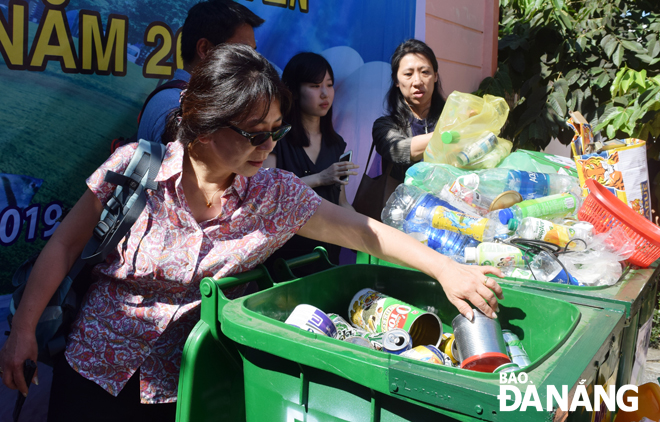City promote sorting of trash at source
Since May, in the light of the COVID-19 pandemic being basically contained across Da Nang, the classification of solid waste at the source has been on the upward trend, bringing some positive results.
 |
| Yokohama experts guiding residents in the wards of Thuan Phuoc and Thach Thang on how to classify garbage at the source in appropriate manner |
In the context of the Khanh Son Landfill in Lien Chieu District’s Hoa Khanh Nam Ward is expected to be full by 2020, and the city is seeking an optimal waste-to-energy technological solution, the waste classification at the source is now an urgent need.
The Hoa Nhon Commune Women's Union in Hoa Vang District has encouraged local residents to use banana leaves instead of plastic for packaging vegetables, a great way to reduce single-use plastic, in its bid to join Da Nang's fight against plastic pollution.
in a similar vein, the waste classification movement has drawn the public attention in Hai Chau District. Last year alone, wards across the downtown district earned 1 billion VND from the sales of more than 300 tonnes of waste.
The Hoa Thuan Tay Ward Women’s Union in Hai Chau District has appealed for residents to collect and clean used nylon bags in order for them to be then sent to the headquarters of the ward’s authorities for proper treatment, instead of throwing them into dustbins for final disposal at the Khanh Son landfill as previously. These nylon bags are swapped for vegetables and lovely environmentally friendly items.
Such meaningful activity aims at raising public awareness of the harmful impacts of plastic waste on the environment, encouraging them to consume biodegradable products, and promote the classification of trash right at families into 3 types - organic, inorganic, and recycled.
With the help of Yokohama City in Japan and the Japan International Cooperation Agency (JICA), in August 2017, the Da Nang People's Committee approved a plan to implement the pilot waste classification at the source in the wards of Thuan Phuoc and Thach Thang, both in Hai Chau District over the 2017-2018 period.
The Da Nang government has provided 13 wards citywide with 185 3-compartments dustbins, 39 waste wheelie bins for safe disposal of hazardous waste, 1,359 manuals on the guidelines on rubbish sorting, 8,000 environmental leaflets and 44,100 environmentally friendly bags. Besides, JICA has donated 5 dustbins and 4 garbage trucks to the city.
The Tho Quang Ward authorities, the district’s Natural Resources and the Environment Office and CECR are joining efforts to implement the ‘Collection of rubbish at home’ and ‘Green Houses, Green Gates’ models in the residential area Thanh Vinh 4.
Da Nang has set a target of collecting 95% of solid waste for treatment over the 2019 – 2025 period, with 12% and 15% to be recycled and reused in 2020 and 2025 respectively.
The city expects to expand the waste classification at source initiative across the city by 2022. In the 2021-2022 period, solid waste in the city will be classified into 4 categories: recyclable waste, such as paper, plastic and metal; toxic waste, such as batteries and light bulbs; construction waste; and other types of waste.
By HOANG HIEP – Translated by A.T








